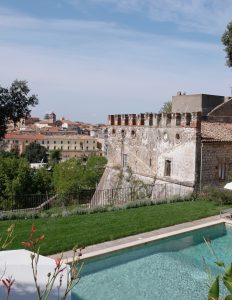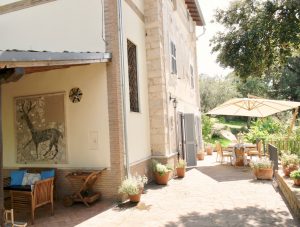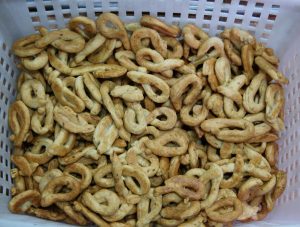John Brown has been a wine and food columnist in West Virginia since the 1980’s. His regular columns appear in the Charleston (WV) Gazette-Mail under the title Vines & Vittles.
Sampling Italian wine and food at the Source
I recently returned from an overseas trip where I ate and drank like Nero in and around a noble estate located in the hills not too far from Rome. And while I may be slightly exaggerating the quantities of food and wine I consumed, I did feel like Roman nobility since I stayed at a villa overlooking an Italian castle.
In fact, I had the privilege of staying at Villa DiTrapano, a beautifully appointed lodging facility located in the mountain village of Sezze about one hour southeast of Rome. Charleston Attorney Rudy DiTrapano and his family own the villa and a 17th century Castelletto (castle) on the property that is currently being restored. Check out their website at: www.villaditrapano.com/

Rome is the capitol of Lazio (pronounced Lat-zee-oo) and of the entire country. Lazio is one of 20 states or provinces in Italy, but I had never visited any other part of this region near Rome. And I had certainly never experienced the wines of Lazio. But that changed very quickly as our group tasted our way through as many of the local wines as we could.
You’ve probably never heard of wines made from grapes such as nero buono (red) or bombino bianco (white), but these vines produce exceptionally good bottles of wine. Lazio also makes wines such as syrah and trebbiano that you probably have sampled, but when I’m in a new area, I love to drink the indigenous varieties.

It always amazes me to discover that no matter where I travel, the best wines are the ones that are made from vines which are native to the area. Whether you’re in the Cori Valley of Lazio drinking bombino or in the Willamette Valley of Oregon sipping pinot noir, you won’t go wrong drinking local.
And every region and sub-region of Italy seems to be known for specialty foods. My wife and I also spent several days in Apulia along the heel of the Italian boot and reveled in the cornucopia of diverse food and wine. We visited and tasted our way through picturesque towns such Martina Franca that is the capocollo capital of Italy.

In Martina Franca, we visited a butcher who demonstrated how capocollo is made. Meat from the neck of locally raised pigs is salted, marinated in a cooked wine with spices, stuffed in a natural casing, smoked and then hung to cure for up to six months. The resulting thinly sliced capocollo is a delicious treat, especially when accompanied by the full-flavored red wines of Apulia such as primitivo or negroamaro.
Back in Sezze, we were delighted by the quality of the local restaurants and the friendliness of the citizens, most of whom tolerated our feeble, but well-intentioned attempts to communicate with them in Italian. Fortunately, most everyone under 40 spoke English.

And right outside the gates leading to Villa DiTrapano, we could walk and find everything, including fresh fruits and vegetables, meats and seafood, excellent bread, wines and spirits and mouth-watering pastries. We could not get enough of the small, circular, biscotti-type cookies called Taralli that were coated with cinnamon and sugar. Taralli produced in other regions can be seasoned with herbs and/or salt and pepper, but the Tarali made in Sezze were addictively sweet treats.

The fully-equipped kitchen at Villa DiTrapano was too much of a temptation for us to ignore so we prepared our own feast of pasta with porcini mushrooms, sautéed hot and sweet peppers, grilled local Bisteca (rib-eye), fresh salad and – of course – bombino bianco and nero buono.
Oh, and we finished the meal off with little rounds of Taralli!
In fact, I had the privilege of staying at Villa DiTrapano, a beautifully appointed lodging facility located in the mountain village of Sezze about one hour southeast of Rome. Charleston Attorney Rudy DiTrapano and his family own the villa and a 17th century Castelletto (castle) on the property that is currently being restored. Check out their website at: www.villaditrapano.com/

Rome is the capitol of Lazio (pronounced Lat-zee-oo) and of the entire country. Lazio is one of 20 states or provinces in Italy, but I had never visited any other part of this region near Rome. And I had certainly never experienced the wines of Lazio. But that changed very quickly as our group tasted our way through as many of the local wines as we could.
You’ve probably never heard of wines made from grapes such as nero buono (red) or bombino bianco (white), but these vines produce exceptionally good bottles of wine. Lazio also makes wines such as syrah and trebbiano that you probably have sampled, but when I’m in a new area, I love to drink the indigenous varieties.

It always amazes me to discover that no matter where I travel, the best wines are the ones that are made from vines which are native to the area. Whether you’re in the Cori Valley of Lazio drinking bombino or in the Willamette Valley of Oregon sipping pinot noir, you won’t go wrong drinking local.
And every region and sub-region of Italy seems to be known for specialty foods. My wife and I also spent several days in Apulia along the heel of the Italian boot and reveled in the cornucopia of diverse food and wine. We visited and tasted our way through picturesque towns such Martina Franca that is the capocollo capital of Italy.

In Martina Franca, we visited a butcher who demonstrated how capocollo is made. Meat from the neck of locally raised pigs is salted, marinated in a cooked wine with spices, stuffed in a natural casing, smoked and then hung to cure for up to six months. The resulting thinly sliced capocollo is a delicious treat, especially when accompanied by the full-flavored red wines of Apulia such as primitivo or negroamaro.
Back in Sezze, we were delighted by the quality of the local restaurants and the friendliness of the citizens, most of whom tolerated our feeble, but well-intentioned attempts to communicate with them in Italian. Fortunately, most everyone under 40 spoke English.

And right outside the gates leading to Villa DiTrapano, we could walk and find everything, including fresh fruits and vegetables, meats and seafood, excellent bread, wines and spirits and mouth-watering pastries. We could not get enough of the small, circular, biscotti-type cookies called Taralli that were coated with cinnamon and sugar. Taralli produced in other regions can be seasoned with herbs and/or salt and pepper, but the Tarali made in Sezze were addictively sweet treats.

The fully-equipped kitchen at Villa DiTrapano was too much of a temptation for us to ignore so we prepared our own feast of pasta with porcini mushrooms, sautéed hot and sweet peppers, grilled local Bisteca (rib-eye), fresh salad and – of course – bombino bianco and nero buono.
Oh, and we finished the meal off with little rounds of Taralli!
